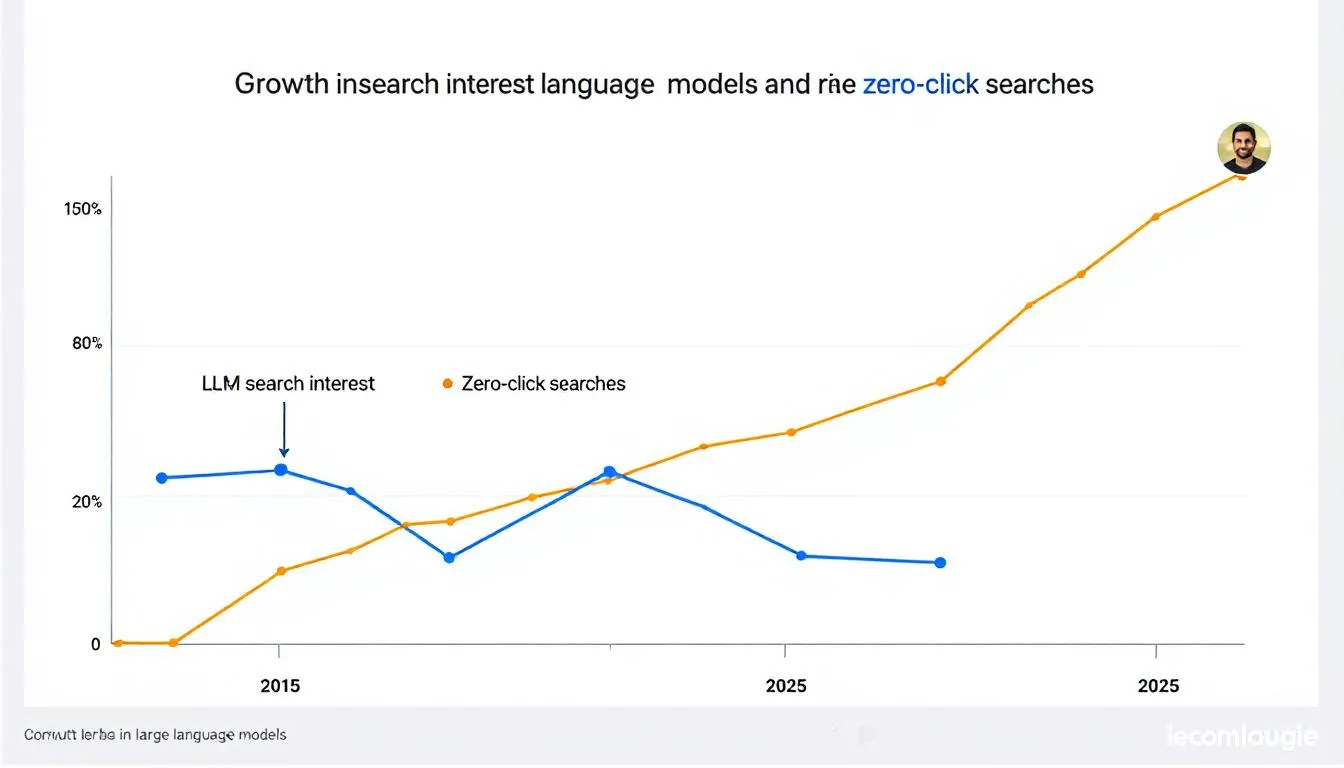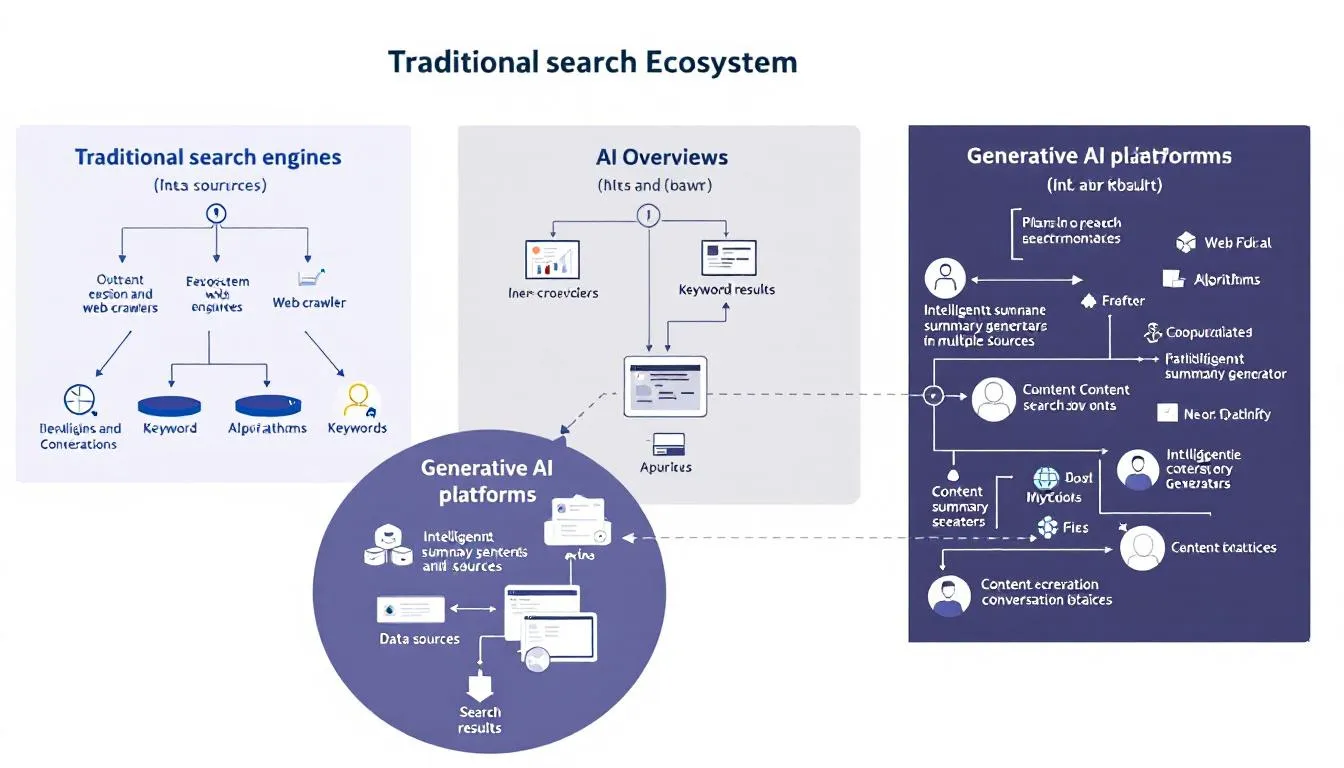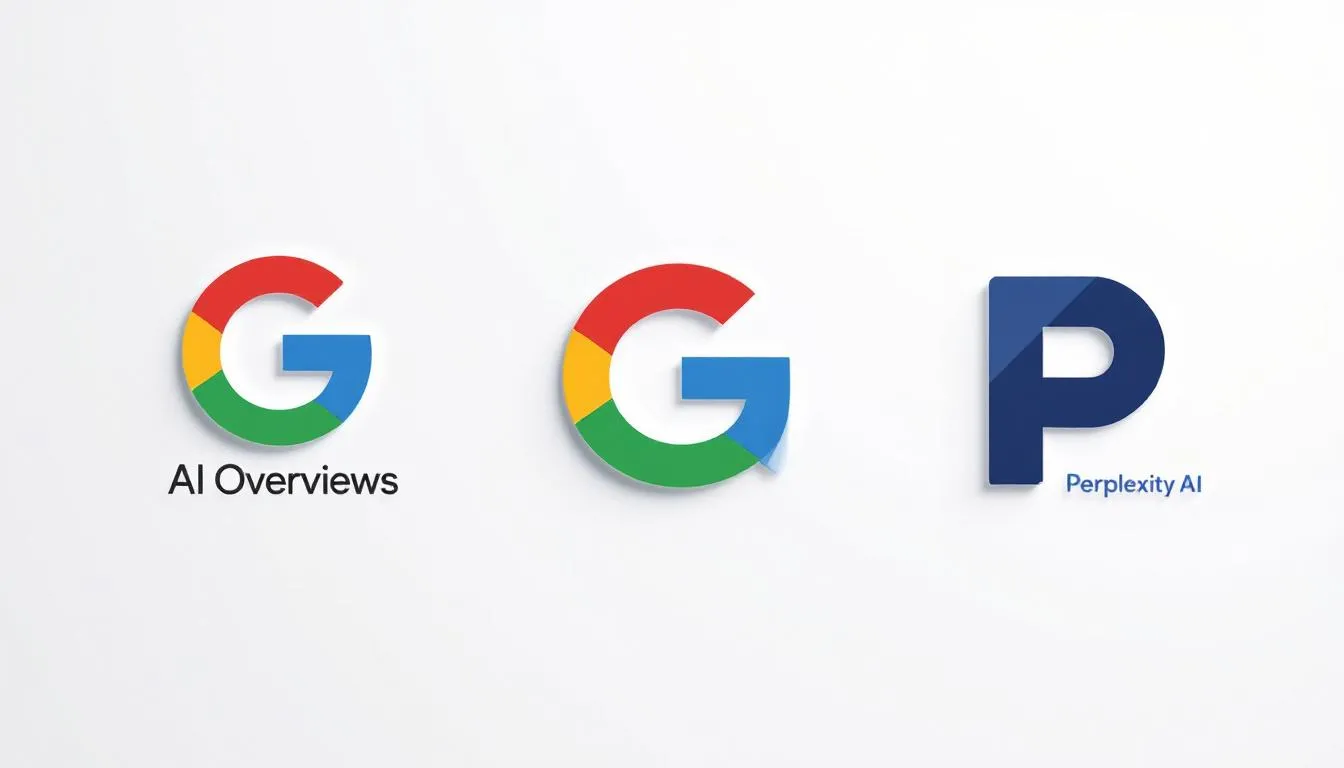What This Guide Covers
This comprehensive analysis provides concrete strategies for Generative Engine Optimisation (GEO) alongside traditional SEO practices, specific tactical approaches for Google AI Overviews and ChatGPT visibility, and multi-platform search optimisation frameworks. This guide does NOT cover basic SEO fundamentals, historical SEO practices, or general digital marketing concepts—it assumes advanced practitioner knowledge.
Who This Is For
This guide is designed for SEO professionals and digital marketing heads managing enterprise-level search strategies. Whether you’re a seasoned practitioner adapting to AI powered search or a content strategist preparing for the projected 25% drop in traditional search volume by 2026, you’ll find actionable frameworks for maintaining search visibility across evolving platforms.
Why This Matters
The search landscape is fragmenting rapidly, with LLM search interest surging 4,850% in five years and AI systems fundamentally changing how users discover information. Zero click searches dominated by AI generated overviews are forcing a complete rethink of how we measure SEO success and optimise for user intent beyond just keywords.

What You’ll Learn:
-
Implementing GEO tactics that increase visibility by 30-40% in AI generated responses
-
Optimising content structure for Google AI Overviews and answer engines
-
Balancing traditional SEO with emerging AI driven search platform requirements
-
Measuring success in a multi-platform, AI powered search ecosystem
Understanding the AI-Driven Search Landscape
The current search ecosystem encompasses traditional search engines, AI overviews, and standalone generative AI platforms that fundamentally alter how users interact with search queries. Unlike the keyword matching systems of the past, generative AI understands context, processes natural language queries, and synthesises information from multiple sources to provide direct answers rather than lists of web pages.

This transformation affects every aspect of digital marketing strategies, from content creation to technical SEO implementation. Where we once optimised for featured snippets and knowledge panels, we now must consider how AI systems parse, understand, and cite our content across multiple platforms.
Traditional SEO vs. Generative Engine Optimisation
Traditional SEO focuses on keyword research, backlinks, and search rankings within the dominant search engine’s results pages. The goal was driving organic traffic through high SERP positions, optimising meta tags, and avoiding keyword stuffing while building domain authority.
Generative Engine Optimisation targets AI generated responses, conversational queries, and citation-based visibility across answer engines like ChatGPT, Perplexity, and Google’s Search Generative Experience. This connects to traditional SEO because GEO complements rather than replaces established optimisation practices, requiring a unified content strategy that serves both traditional search results and AI platforms.
Major AI Search Platforms Shaping 2025
Google AI Overviews represent the integration of generative AI into the world’s most-used search engine, appearing above traditional organic search results and synthesising information from multiple sources. ChatGPT’s search capabilities continue expanding its user base beyond conversational AI into direct search competition. Perplexity AI’s cite-source approach provides an ad-free model that emphasises source attribution and factual accuracy.

Building on this foundation, these platforms require different optimisation approaches than traditional Google SEO, emphasising structured data, natural language processing compatibility, and multi-platform content distribution strategies.
Transition: Understanding these platforms’ unique requirements leads directly to specific optimisation strategies that maximise visibility across the evolving search landscape.
💡 Introducing Cross Engine Optimisation (XEO)
As the search environment becomes more fragmented with traditional search engines, generative AI platforms, and emerging discovery channels, a new holistic approach is essential: Cross Engine Optimisation (XEO).
XEO is the strategic framework for optimising content and digital presence across all platforms—old, new, and emerging. It combines traditional SEO, generative engine optimisation (GEO), and platform-specific tactics into a unified strategy that ensures consistent visibility and authority regardless of where users begin their search journey.
Key Components of XEO
-
Unified Content Strategy: Develop content that meets the requirements of traditional search algorithms while being structured and enriched for AI-driven platforms.
-
Multi-Platform Distribution: Expand content reach by leveraging social media, forums, video platforms, and AI citation sources to build authority and referral traffic.
-
Consistent Brand Signals: Maintain strong E-E-A-T signals and brand presence across all channels to build trust with both humans and AI systems.
-
Technical Integration: Ensure technical SEO, schema markup, and mobile optimisation support discoverability across diverse engines.
XEO prepares businesses for the evolving search landscape by fostering adaptability and maximising reach across all user touchpoints.
AI-Powered Search Optimisation Strategies
The shift from optimising for search engines to optimising for AI systems requires fundamental changes in content structure, authority building, and distribution approaches that reflect how machine learning algorithms parse and recommend information.
Content Structure for AI Parsing
Clear headings, bullet points, and direct answer formats improve how AI tools understand and cite your content. Conversational, long-tail query optimisation addresses natural language processing capabilities that interpret user intent beyond traditional keyword matching. Statistical evidence and source citations significantly improve AI generated responses’ likelihood of including your content.
Structure content with answer-first formatting that immediately addresses search intent, use schema markup to help AI systems understand context, and implement technical SEO best practices that support both traditional search engines and generative engines.
E-E-A-T Optimisation for AI Trust Signals
Experience, Expertise, Authoritativeness, and Trustworthiness (E-E-A-T) factors heavily influence AI generated content recommendations across platforms. Building brand authority requires consistent expertise signals across diverse sources—from your website’s visibility to user generated content on social platforms. Unlike traditional link building focused on domain authority, AI platforms prioritise demonstrated subject matter expertise across multiple platforms and content formats.
Establish author credentials, maintain consistent brand messaging across channels, and create content that demonstrates deep industry knowledge while following Core Web Vitals and mobile optimisation standards that support overall website performance.
Multi-Platform Content Distribution
Creating content strategies that span YouTube, TikTok, Reddit, Quora, and traditional websites ensures visibility as users interact with different discovery channels. The 300% increase in referral traffic from AI platforms to websites in late 2024 demonstrates the importance of optimising beyond traditional search.
Develop voice search compatibility for audio queries, optimise for visual search and multimodal search capabilities, and ensure your content appears in answer engine optimisation contexts across platforms where your target audience conducts research.
Key Points:
-
AI systems prioritise clear, direct answer formats over traditional keyword density
-
E-E-A-T signals must be consistent across multiple platforms, not just your website
-
Content distribution strategy determines visibility in AI driven search results
Transition: These optimisation strategies require systematic implementation through proven frameworks that balance efficiency with effectiveness.
Implementation Framework for Future-Ready SEO
Converting AI powered search optimisation strategies into actionable workflows requires structured approaches that integrate seamlessly with existing digital marketing strategies while addressing the unique requirements of generative AI platforms.
Step-by-Step: GEO Content Optimisation
When to use this: For informational content targeting AI generated responses and answer engines where user satisfaction depends on immediate, accurate answers.
-
Research AI Overview Content: Analyse current AI overviews in your industry to understand preferred content formats, citation patterns, and answer structures that achieve visibility.
-
Implement GEO Tactics: Apply Cite Sources, Quotation Addition, and Statistics Addition tactics proven to boost visibility by 30-40% in AI responses through authoritative source attribution.
-
Structure Answer-First Content: Format content with direct answers to user queries in the opening paragraphs, followed by supporting evidence and context that satisfies search intent.
-
Test Multi-Platform Performance: Monitor content performance across Google AI Overviews, ChatGPT, and Perplexity to identify optimisation opportunities and iterate based on AI systems’ citation patterns.
Comparison: Traditional SEO vs. GEO Investment
|
Feature
|
Traditional SEO Focus
|
GEO Focus
|
|
Primary Metrics
|
Search rankings, click through rates, organic traffic
|
AI citations, brand mentions, multi-platform visibility
|
|
Content Format
|
Keyword-optimised pages, meta tags optimisation
|
Conversational content, structured data, direct answers
|
|
Success Measurement
|
Website traffic, SERP positions, conversion rates
|
AI response inclusion, source attribution, user satisfaction
|
|
Resource Allocation
|
Link building, technical SEO, on-page optimisation
|
Multi-platform presence, semantic search optimisation, natural language content
|
|
This comparison demonstrates that successful engine optimisation in 2025 requires balancing both approaches rather than abandoning traditional SEO for generative engines exclusively. Allocate approximately 70% of resources to traditional SEO while dedicating 30% to GEO initiatives based on industry performance data.
|
|
|
Transition: Even with proper frameworks, implementation challenges require specific solutions that address the realities of transitioning to AI-inclusive search strategies.
Common Challenges and Solutions
These challenges represent the most frequent obstacles faced by marketing teams transitioning from traditional search optimisation to AI-inclusive strategies that maintain website’s traffic while building visibility in generative AI platforms.
⚠️ Challenge 1: Measuring ROI in Zero-Click Search Environment
Solution: Focus on brand visibility metrics, AI mention tracking, and multi-touch attribution models that account for search behaviour changes where users consume information without visiting web pages.
Traditional metrics like website traffic and click-through rates become insufficient when 58% of searches end without clicks, requiring new KPIs that measure influence and authority across the entire search journey.
⚠️ Challenge 2: Content Quality vs. AI-Generated Content Scale
Solution: Use AI tools for efficiency while maintaining human expertise and fact-checking to ensure E-E-A-T compliance and brand authenticity in AI generated content.
While 50% of marketers now use AI tools for content creation, human oversight ensures credibility, prevents keyword stuffing through AI generation, and maintains the key elements that distinguish authoritative content from automated output.
⚠️ Challenge 3: Resource Allocation Between Traditional and AI Search
Solution: Implement an integrated approach with 70% traditional SEO and 30% GEO investment based on current industry performance data and gradual market transition patterns.
Google remains the highest-reach platform despite declining market share, making it essential to maintain Core Web Vitals, local SEO, and technical SEO standards while building competency in AI driven optimisation.
Transition: These solutions provide the foundation for immediate implementation while preparing for continued evolution in search technology.
👉 Conclusion and Next Steps
The future of SEO requires balancing traditional optimisation practices with AI driven search strategies as generative engines reshape how users discover and consume information. Success depends on maintaining excellence in established practices while building competency in generative engine optimisation, semantic search, and multi-platform visibility.
As AI overviews expand and answer engines capture increasing market share, the organisations that adapt quickly while preserving their core expertise will maintain competitive advantage. The transition is complex, but three decades of search industry evolution have consistently rewarded those who embrace change while maintaining focus on user satisfaction and relevant content delivery.
To get started:
-
Audit Current Content: Evaluate your highest-traffic informational content for AI Overview optimisation opportunities using structured data and answer-first formatting.
-
Implement GEO Tactics: Apply citation, quotation, and statistics addition strategies to your most important pages targeting AI generated responses.
-
Establish Monitoring Systems: Set up AI platform tracking using tools like LLM Scout, Cognizo AI, and getSAO to measure GEO performance across multiple platforms.
Related Topics: Consider exploring technical SEO evolution for AI compatibility, voice search optimisation strategies, and local SEO AI integration as natural extensions of these foundational concepts.
📚 Additional Resources
Research Foundation: The Princeton/Georgia Tech GEO research study provides empirical evidence for optimisation tactics that improve visibility in AI generated responses by 30-40% through systematic testing across major platforms.
Monitoring Tools: LLM Scout, Cognizo AI, and getSAO offer GEO tracking capabilities that measure brand mentions and citation frequency across generative AI platforms, complementing traditional Search Engine Land analytics.
Platform Documentation: Google Search Central’s AI Overviews documentation and best practices provide official guidance for optimising content for Google’s Search Generative Experience and maintaining compliance with evolving guidelines.












